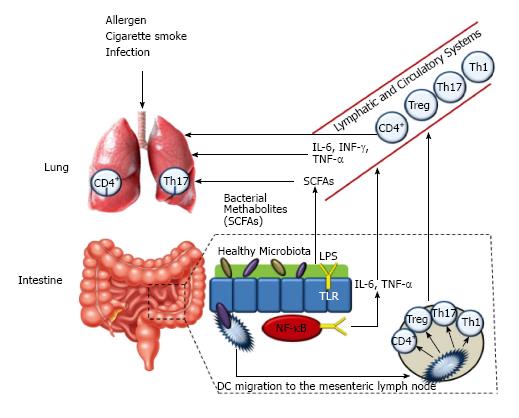Copyright
©The Author(s) 2017.
World J Respirol. Jul 28, 2017; 7(2): 39-47
Published online Jul 28, 2017. doi: 10.5320/wjr.v7.i2.39
Published online Jul 28, 2017. doi: 10.5320/wjr.v7.i2.39
Figure 3 Model of intestinal microbiome effects on lung immunology (adapted from Samuelson DR 2015).
Microbes in the intestine is sampled by dendritic cells (DCs) either directly from the lumen or following translocation through M-cells to the gut-associated lymphoid tissue. A combination of signals from the microbes results in phenotypic changes in the DCs. DCs promote activation of various T-cell subsets within the mesenteric lymph nodes (MLN) and production of regulatory cytokines. Following the immune challenge in the airways T-cells activated in the gastrointestinal associated lymphoid tissue (GALT) and MLN move to the respiratory mucosa where they promote protective and anti-inflammatory responses. Production of various bacterial metabolites (e.g., SCFAs) also affects the gut-lung axis, as these products get to the lung, where they can alter the levels of inflammation. SCFA: Short chain fatty acid; IL: Interleukin; TNF: Tumor necrosis factor.
- Citation: Evsyutina Y, Komkova I, Zolnikova O, Tkachenko P, Ivashkin V. Lung microbiome in healthy and diseased individuals. World J Respirol 2017; 7(2): 39-47
- URL: https://www.wjgnet.com/2218-6255/full/v7/i2/39.htm
- DOI: https://dx.doi.org/10.5320/wjr.v7.i2.39









